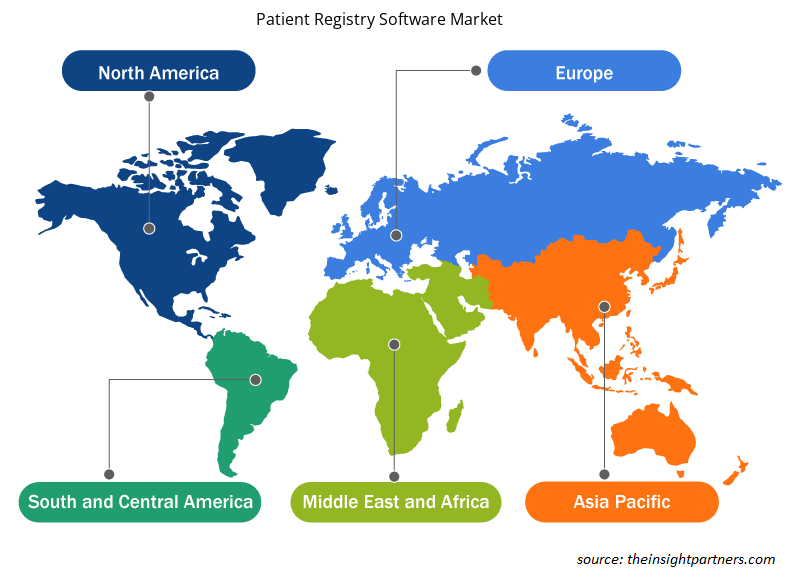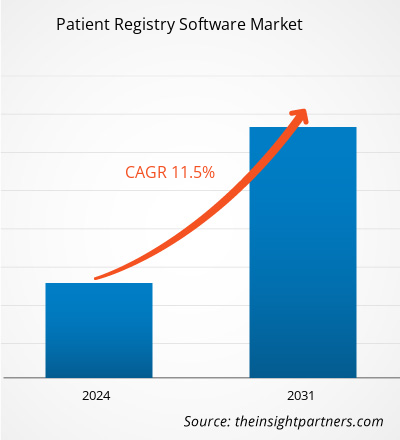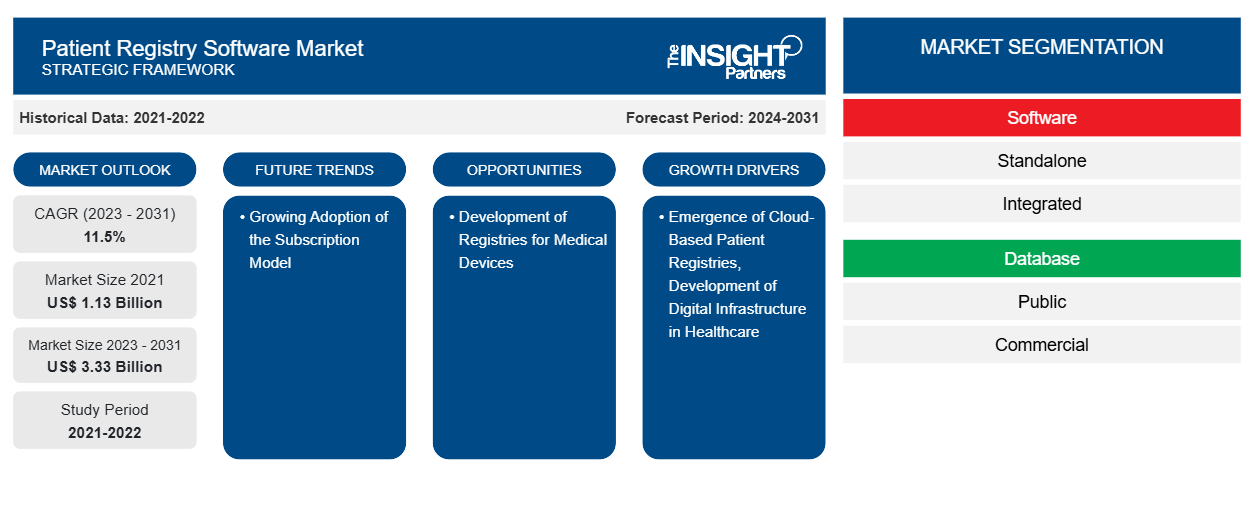2021 年患者注册软件市场规模为 11.3 亿美元,预计到 2031 年将达到 33.3 亿美元。预计 2023-2031 年市场复合年增长率为 11.5%。医疗器械注册的发展可能仍是患者注册软件市场的主要趋势。
患者登记软件市场分析
全球慢性病患病率的上升预计将支持市场的增长。由于糖尿病、心血管疾病、癌症和其他疾病的患病率上升,对电子健康记录 (EHR) 的需求大幅增加。由于降低成本的压力越来越大、政府实施有利举措以及社交媒体和移动技术的普及度不断提高,医疗保健行业正在经历一场值得注意的转型。预计所有这些因素都将在预测期内使患者登记软件市场受益。
患者登记软件市场概况
患者注册软件包含通过收集与患者的诊断、程序或病情相关的二手数据来维护的数据库,用于记录正在使用或正在经历新程序的新医疗器械的数量。患者注册软件在药品上市后监测中至关重要。2020 年 12 月,欧盟向多个数字健康项目拨款 6600 万美元,旨在抗击 COVID-19 大流行等健康危机,并在欧洲建立数字和人工智能基础设施。财政援助鼓励数字健康企业在患者注册软件市场开发和推出先进产品。因此,数字工具在医疗保健结构中的不断涌入推动了市场的增长。
定制此报告以满足您的需求
您可以免费定制任何报告,包括本报告的部分内容、国家级分析、Excel 数据包,以及为初创企业和大学提供优惠和折扣
-
获取此报告的关键市场趋势。这个免费样品将包括数据分析,从市场趋势到估计和预测。
患者登记软件市场驱动因素和机遇
基于云的患者登记系统的出现推动了市场增长
自过去几年以来,独立医生一直在使用基于云或基于网络的 EHR。各种组织都在为众多医疗状况和程序创建和开发基于云的注册表。例如,孤儿病中心与医疗信息学公司 Pulse Infoframe 合作,基于云技术建立了一套罕见病患者登记册。Allscripts 与 Northwell Health 于 2019 年 10 月签署了一项创新协议,以生成下一代 EHR。该计划支持大量创收。此外,基于云的软件服务在成本方面使用效率高,因为这些服务只需为所需的服务和注册表付费。因此,基于云的患者登记册的出现正在推动市场扩张。
订阅模式日益普及,利于市场增长
订阅模式最大限度地降低了前期成本,减轻了医疗保健系统的压力,因为不需要 IT 人员。因此,成本效益和生产率上升。为了以新颖的方式接触潜在客户和消费者,这种模式还使供应商能够创建创新和创造性的许可模式。订阅模式的软件在医疗保健提供商中越来越受欢迎,因为它可以更快地为程序中添加的任何新功能创造价值,甚至可以根据需要在有限的时间内使用。订阅模式也得到了一些行业参与者的推广,因为它提供了更大的机会来建立信任并理解医疗保健提供商的需求,最终提高客户满意度。这些好处为市场参与者提供了扩张的机会,从而推动了预测期内市场的增长。
患者登记软件市场报告细分分析
有助于得出患者注册软件市场分析的关键部分是软件、数据库、注册类型、交付方式和定价模型。
- 根据软件,患者登记软件市场分为独立软件和集成软件。集成软件在 2023 年占据最大市场份额,预计在预测期内将实现最高复合年增长率。
- 根据数据库,市场分为公共和商业。商业领域在 2023 年占据了最大的市场份额,预计在预测期内将实现最高的复合年增长率。
- 就注册类型而言,市场分为产品注册、疾病注册、健康服务注册。疾病注册部分在 2023 年占据最大的市场份额,预计在预测期内将实现最高的复合年增长率。
- 根据交付方式,患者登记软件市场分为本地和基于云。基于云的部分在 2023 年占据了最大的市场份额,预计在预测期内将实现最高的复合年增长率。
- 根据定价模式,市场分为订阅和所有权。订阅部分在 2023 年占据了最大的市场份额,预计在预测期内将实现最高的复合年增长率。
患者登记软件市场份额按地区分析
患者登记软件市场报告的地理范围主要分为五个区域:北美洲、亚太地区、欧洲、中东和非洲、南美洲和中美洲。
北美主导着患者登记软件市场。北美市场正在扩大,原因有多种,包括完善的电子健康记录、不断发展的医疗保健数字基础设施以及患者对患者登记好处的认识不断提高。随着市场中各主要参与者收购区域供应商和登记收集者以加强其现有地位,该地区的患者登记软件市场可能会增长。此外,联邦政府有义务将数字工具的使用整合到医疗保健运营中,以提高质量并同时降低成本,这也有助于促进该地区市场的增长。预计亚太地区将在未来几年以最高的复合年增长率增长。由于该地区医疗中心的出现、医疗保健 IT 行业的增长、对数字健康的日益重视、对流程精简的关注以及政府的支持性政策,该地区的市场可能会见证相当大的增长。
患者登记软件市场区域洞察
Insight Partners 的分析师已详尽解释了预测期内影响患者登记软件市场的区域趋势和因素。本节还讨论了北美、欧洲、亚太地区、中东和非洲以及南美和中美洲的患者登记软件市场细分和地理位置。

- 获取患者登记软件市场的区域特定数据
患者登记软件市场报告范围
| 报告属性 | 细节 |
|---|---|
| 2021 年市场规模 | 11.3亿美元 |
| 2031 年市场规模 | 33.3亿美元 |
| 全球复合年增长率(2023 - 2031) | 11.5% |
| 史料 | 2021-2022 |
| 预测期 | 2024-2031 |
| 涵盖的领域 |
按软件
|
| 覆盖地区和国家 |
北美
|
| 市场领导者和主要公司简介 |
|
患者登记软件市场参与者密度:了解其对业务动态的影响
患者登记软件市场正在快速增长,这得益于终端用户需求的不断增长,而这些需求又源于消费者偏好的不断变化、技术进步以及对产品优势的认识不断提高等因素。随着需求的增加,企业正在扩大其产品范围,进行创新以满足消费者的需求,并利用新兴趋势,从而进一步推动市场增长。
市场参与者密度是指在特定市场或行业内运营的企业或公司的分布情况。它表明在给定市场空间中,相对于其规模或总市场价值,有多少竞争对手(市场参与者)存在。
在患者登记软件市场运营的主要公司有:
- IQVIA 公司
- Evado 临床
- 雪松
- IBM 公司
- FIGmd 公司
- 医疗流
免责声明:上面列出的公司没有按照任何特定顺序排列。

- 获取患者登记软件市场顶级关键参与者概述
患者登记软件市场新闻和最新发展
患者登记软件市场通过收集主要和次要研究后的定性和定量数据进行评估,其中包括重要的公司出版物、协会数据和数据库。以下是患者登记软件市场的发展和策略列表:
- Seqster PDM, Inc. 是一家领先的以患者为中心的医疗技术公司,与国家胰腺基金会达成多年合作伙伴关系,旨在创建该国最大、最全面的胰腺疾病患者登记处。由 Seqster 提供支持的创新型新登记处可连接到任何 EHR、基因组 DNA 测试和可穿戴/远程监控设备,为患者提供实时完整的纵向健康记录。(来源:Seqster PDM, Inc.,新闻稿,2022 年)
- 美国儿科学会选择 ArborMetrix 作为合作伙伴,开发和发展临床登记处,以促进所有儿童的健康、福祉和发展。该计划名为“通过纵向数据改善儿童健康 (CHILD) 登记处”,支持 AAP 的 67,000 名会员儿科医生通过使用真实世界数据改善儿童健康。它安全地收集、存储和分析全美儿童的健康数据。(来源:ArborMetrix,新闻稿,2020 年)
患者登记软件市场报告覆盖范围和交付成果
“患者登记软件市场规模和预测(2021-2031)”报告对市场进行了详细分析,涵盖以下领域:
- 范围内涵盖的所有主要细分市场的全球、区域和国家层面的市场规模和预测
- 市场动态,如驱动因素、限制因素和关键机遇
- 未来主要趋势
- 详细的 PEST/波特五力分析和 SWOT 分析
- 全球和区域市场分析涵盖关键市场趋势、主要参与者、法规和最新市场发展
- 行业格局和竞争分析,涵盖市场集中度、热点图分析、知名参与者和最新发展
- 详细的公司简介
- 历史分析(2 年)、基准年、预测(7 年)及复合年增长率
- PEST和SWOT分析
- 市场规模、价值/数量 - 全球、区域、国家
- 行业和竞争格局
- Excel 数据集
近期报告
相关报告
客户评价
购买理由
- 明智的决策
- 了解市场动态
- 竞争分析
- 客户洞察
- 市场预测
- 风险规避
- 战略规划
- 投资论证
- 识别新兴市场
- 优化营销策略
- 提升运营效率
- 顺应监管趋势























 获取免费样品 - 患者登记软件市场
获取免费样品 - 患者登记软件市场